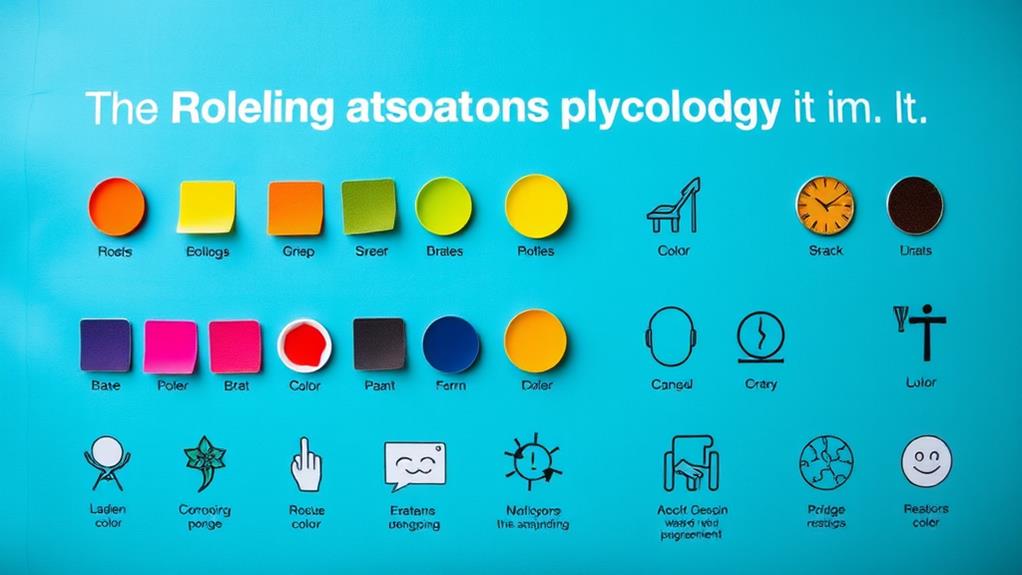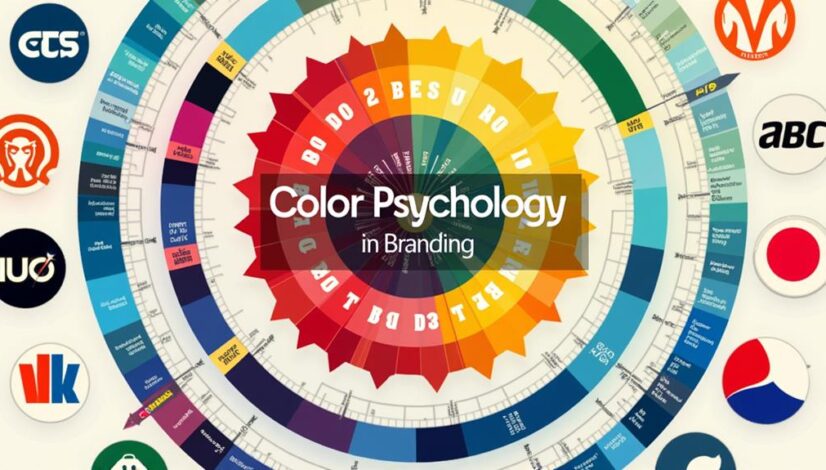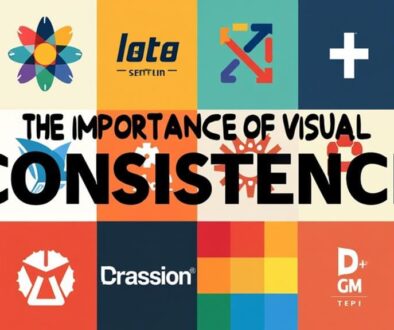The Role of Color Psychology in Branding
Color psychology plays an essential role in branding, as colors evoke specific emotional responses that greatly influence consumer behavior. Different colors carry unique meanings and cultural associations; for instance, blue often fosters trust, while red generates excitement. Understanding these emotional triggers enhances brand recognition and loyalty. Additionally, strategic color combinations can transform a brand's visual identity, making it memorable and cohesive. By rigorously researching demographics and market trends, brands can effectively utilize color to resonate with their audience. For brands looking to strengthen their impact, exploring the nuances of color psychology offers invaluable insights.
Key Takeaways
- Color symbolism significantly influences consumer perceptions, shaping emotional responses that impact brand loyalty and purchasing decisions.
- Different cultures interpret colors variably, necessitating careful market research to align branding strategies with local meanings.
- Strategic color selection fosters a cohesive visual identity, enhancing brand recognition and consumer connection across diverse platforms.
- Emotional branding through color can effectively segment markets by demographics, evoking specific feelings that resonate with target audiences.
- Consistent application of color contrasts and harmony improves readability and retention of brand messages, enhancing overall consumer engagement.
Understanding Color Psychology

Color psychology is an important component in the domain of branding, influencing consumer perception and behavior in profound ways. At its core, color psychology revolves around color symbolism—the idea that specific colors evoke particular meanings and associations that can shape consumer attitudes toward a brand. For instance, blue often conveys trust and dependability, making it a popular choice among financial institutions. Conversely, red can evoke excitement and urgency, frequently employed in sales promotions to spur immediate action.
Understanding these symbolic associations is vital for brands aiming to craft a resonant identity. However, the effective application of color psychology extends beyond mere symbolism; it necessitates a keen awareness of color harmony—the aesthetically pleasing arrangement of colors that can enhance a brand's visual identity.
When colors are harmonized effectively, they create a cohesive and attractive brand presentation that can foster consumer loyalty and recognition. Achieving color harmony involves selecting colors that complement and contrast in a way that resonates with the target audience. This strategic approach can amplify the intended message of the brand, ensuring that the colors not only represent the brand values but also appeal to consumers' subconscious preferences.
Brands that master the interplay of color symbolism and color harmony are better equipped to create an emotional connection with their audience, ultimately driving consumer engagement and loyalty. Consequently, a deep understanding of color psychology becomes a powerful tool in the branding arsenal, capable of transforming perceptions and enhancing market presence.
Emotional Responses to Colors
Colors evoke distinct emotional responses that greatly influence consumer behavior and brand perception.
Each hue carries specific associations and meanings, which can vary widely across different cultures, shaping how a brand is interpreted in diverse markets.
Understanding these emotional connections is essential for brands seeking to create compelling narratives that resonate with their target audience.
Color Associations and Meanings
When we encounter different hues, our emotional responses can be both immediate and profound, influencing perceptions and behaviors in ways we often overlook.
Color symbolism plays an essential role in shaping these responses, as specific colors evoke distinct feelings and associations. For instance, red often signifies passion or urgency, while blue tends to evoke calmness and trust. These associations are not arbitrary; they are deeply rooted in cultural and psychological contexts.
Understanding color preferences is vital for brands aiming to resonate emotionally with their audiences. By aligning their visual identity with prevailing color trends, companies can effectively communicate their values and enhance their brand narratives.
For example, green is increasingly associated with sustainability, reflecting a societal shift towards environmental consciousness.
Furthermore, the meanings attached to colors can evolve, influenced by cultural shifts and societal values. Brands that remain attuned to these changes can leverage color psychology to foster stronger connections with consumers.
Ultimately, a nuanced comprehension of color associations and meanings enables brands to craft more compelling identities, ensuring they not only attract attention but also foster lasting emotional bonds with their target audience.
Impact on Consumer Behavior
Emotional responses to colors markedly shape consumer behavior, steering purchasing decisions in subtle yet impactful ways. The interplay between color preferences and sensory perception creates a visceral connection to a brand's visual identity.
For instance, brands leveraging emotional branding can craft a narrative that resonates deeply, enhancing brand recognition and fostering consumer loyalty.
In an era where color trends evolve rapidly, strategic use of color can facilitate effective market segmentation. By aligning colors with specific demographics, brands can enhance their aesthetic appeal, ensuring that their offerings stand out in a saturated market. This brand differentiation is vital, as consumers often make snap judgments based on visual stimuli.
Furthermore, colors can evoke specific emotions that influence buying behavior—warm colors may stimulate excitement, while cool tones can evoke calmness. Understanding these emotional triggers is essential for brands aiming to cultivate lasting relationships with consumers.
Consequently, the impact of color on consumer behavior transcends mere preference; it is a fundamental aspect of strategic branding that ultimately drives engagement and sales. In mastering this dynamic, brands can harness the transformative power of color to shape perceptions and influence the consumer journey effectively.
Cultural Color Interpretations
Different cultures attribute varying meanings and emotional responses to colors, which can markedly influence brand perception and consumer behavior. Understanding these cultural interpretations is critical for brands aiming to resonate with diverse audiences.
For instance, while white symbolizes purity and new beginnings in Western contexts, it often represents mourning and loss in many Eastern cultures. Such color variations underscore the importance of cultural symbolism in branding strategies.
Regional preferences further complicate these dynamics; colors that evoke excitement and positivity in one culture may be viewed with skepticism in another. Traditional meanings tied to colors—like red denoting good fortune in Chinese culture—highlight the cultural significance of color beliefs and their role in consumer decision-making.
Moreover, societal influences, including historical events and local customs, shape cultural perceptions of color, making it imperative for brands to conduct thorough market research.
Color Associations and Meanings

Numerous studies have revealed that colors evoke specific associations and meanings, influencing consumer perceptions and behaviors greatly. Understanding color symbolism is essential for effective branding, as colors possess inherent psychological effects that transcend mere aesthetics. For instance, red often signifies energy and urgency, while blue conveys trust and dependability. These associations can vary greatly across cultures, highlighting their cultural significance and the necessity for brands to be cognizant of diverse interpretations.
In the domain of branding, visual perception plays a pivotal role, as consumers often rely on their sensory associations with colors to form instant judgments about a brand. Color trends can shift rapidly, yet successful brands maintain branding consistency by aligning their color choices with their core values and target demographics. This consistency fosters familiarity and loyalty, essential components of successful emotional branding.
Moreover, the interplay of color harmony and color contrast can enhance a brand's visual identity, making it more memorable. For example, a well-balanced palette can create a sense of cohesion, while strategic contrast can draw attention to key elements, guiding consumer focus.
Impact of Color on Branding
The influence of color on branding is profound, shaping not only consumer perceptions but also driving purchase decisions. As brands navigate the evolving landscape of color trends, they must consider the psychological effects that colors evoke. Each hue carries its own symbolism, influencing how consumers feel about a brand and its offerings. For instance, blue often conveys trust, while red incites urgency—insights that are essential in a time when branding evolution is relentless.
Establishing a strong visual identity hinges on the strategic use of color. Consistency in color application fosters brand recognition, allowing consumers to associate specific colors with particular brands effortlessly. This consistency, paired with thoughtful color harmony, creates a cohesive brand image that resonates with target audiences.
Additionally, sensory branding strategies can amplify the impact of color by engaging multiple senses, enhancing the emotional connection to the brand. Color contrast also plays a significant role, as it can draw attention to key elements within branding materials. When executed properly, it can elevate visual appeal and reinforce the intended message.
In a saturated market, brands that master the art of color utilization can differentiate themselves, creating a memorable presence that lingers in the minds of consumers. Ultimately, understanding the multifaceted impact of color on branding is essential for marketers aiming for mastery. By leveraging color symbolism and the principles of color consistency and contrast, brands can navigate consumer psychology effectively, driving loyalty and increasing market share.
Case Studies in Color Usage

Examining case studies in color usage reveals the intricate strategies brands employ to evoke specific emotions and establish strong consumer connections.
By analyzing successful color combinations, we can uncover the underlying principles that drive brand recognition and preference.
These examples not only illustrate the emotional impact of colors but also serve as a blueprint for effective brand color selection.
Brand Color Selection Strategies
Color selection is a significant element in branding that can greatly influence consumer perception and behavior. Strategic brand color selection involves a nuanced understanding of color harmony and its role in establishing a cohesive brand identity.
Effective use of colors not only enhances visual consistency across platforms but also facilitates market differentiation, allowing brands to stand out in a saturated marketplace.
Employing psychological triggers associated with specific colors can evoke emotional responses, enhancing aesthetic appeal and fostering brand recall. For example, a tech company might adopt a blue palette to convey trustworthiness, while a health brand could use green to symbolize liveliness. Such choices should also align with demographic targeting, ensuring that color schemes resonate with the intended audience.
Trend alignment is equally important; staying attuned to evolving color preferences can bolster relevance. Additionally, employing visual storytelling through color can create a compelling narrative that captivates consumers.
Emotional Impact of Colors
Understanding the emotional impact of colors is essential for brands aiming to connect with consumers on a deeper level. Color symbolism plays a significant role in shaping brand identity, as different hues evoke distinct color emotions. For instance, blue often signifies trust and reliability, making it a popular choice for financial institutions. In contrast, red emanates energy and urgency, frequently employed in food branding to stimulate appetite.
The interplay of color perception and preferences can also shift with evolving color trends, demanding brands remain vigilant in their strategies. A brand's color harmony, or the pleasing arrangement of colors, can enhance visual appeal, while color saturation can influence the intensity of emotional responses. For example, a vibrant, saturated yellow can evoke happiness, while a muted tone may instill calmness.
Moreover, effective color contrast not only enhances visibility but also reinforces brand messaging. By thoughtfully integrating these elements into color branding, companies can create a robust color identity that resonates with their target audience.
Ultimately, understanding the emotional nuances of colors empowers brands to craft compelling narratives that foster loyalty and engagement.
Successful Color Combinations
In the domain of branding, the strategic use of color combinations can greatly enhance visual identity and consumer perception. Successful brands leverage color harmony and contrast to create compelling color palettes that resonate with their target audience.
For instance, the vibrant red and yellow of McDonald's not only stimulates appetite but also embodies a sense of joy and energy, effectively reinforcing their brand identity.
Current color trends, such as the muted tones favored by many tech companies, demonstrate an understanding of cultural symbolism and the desire for authenticity. By employing such color combinations, brands engage in visual storytelling that differentiates them in crowded markets.
Consider Airbnb, which utilizes a soft coral and warm gray, invoking feelings of warmth and belonging, ultimately fostering a connection with users.
Moreover, the use of color contrast can enhance readability and retention, ensuring that brand messages are easily digestible. Effective color combinations not only attract attention but also evoke the intended emotional responses, thereby driving consumer behavior.
In mastering these elements, brands can achieve market differentiation, creating a lasting impact that transcends mere aesthetics and resonates deeply with consumers.
Tips for Effective Color Selection
Selecting the right colors for branding is a critical decision that can greatly influence consumer perception and emotional response. To master color selection, practitioners must prioritize color harmony, ensuring that chosen hues cohesively reflect the brand identity. A well-considered palette resonates with the target audience and evokes the desired emotional triggers that reinforce brand messaging.
To achieve ideal visual appeal, brands should remain cognizant of current market trends while simultaneously embracing timeless color combinations that enhance design consistency. This approach not only attracts attention but also fosters familiarity and trust among consumers.
Employing color contrast effectively can also amplify impact, drawing focus to key elements of a brand, such as logos and call-to-action buttons. Understanding audience perception is paramount. Conducting thorough market research allows brands to tailor their color choices to the psychological triggers relevant to their demographic.
Colors can evoke feelings ranging from excitement to calmness, and aligning these emotions with the brand's core values can create a lasting connection with consumers. Furthermore, testing color variations and obtaining feedback can refine choices, ensuring that the final palette resonates on both an emotional and practical level.
Frequently Asked Questions
How Do Cultural Differences Affect Color Perception in Branding?
Cultural differences greatly influence color perception, as various cultures attribute distinct meanings to colors, often rooted in historical and social contexts.
For instance, while white symbolizes purity in Western cultures, it may represent mourning in some Eastern traditions. Such cultural symbolism shapes emotional responses, affecting consumer behavior and brand perception.
As a result, understanding these nuances is essential for effective communication and engagement in diverse markets, ensuring that branding resonates positively across cultural boundaries.
Can Color Preferences Change Over Time or Trends?
Color preferences are subject to significant evolution, often influenced by prevailing cultural and societal trends.
As aesthetics shift, consumer perceptions of color can also change, reflecting broader movements in fashion, technology, and design.
Trend influence plays a vital role in this dynamic, as popular colors can evoke specific emotions or associations, leading to their increased adoption.
Understanding these fluctuations is essential for effectively engaging audiences and maintaining relevance in an ever-evolving marketplace.
What Role Do Colors Play in Social Media Branding?
Colors greatly influence social media branding by shaping color associations and eliciting emotional responses from audiences. A well-crafted color palette can enhance brand recognition, create a distinctive identity, and foster engagement.
For instance, warm colors may evoke excitement and urgency, while cool colors can convey trust and calmness. Consequently, brands must strategically select colors that align with their values and target demographics, ensuring a cohesive and impactful presence across social media platforms.
How Can Color Psychology Be Tested Before Launching a Brand?
Ah, the elusive quest for the perfect color—akin to finding the Holy Grail of branding!
To effectively test color psychology before launching a brand, implement color testing through A/B testing with target demographics.
Analyze brand perception by gathering data on emotional responses and preferences.
This method not only refines your palette but also guarantees your brand resonates meaningfully, enhancing consumer connection and loyalty in an increasingly vibrant marketplace.
Are There Specific Colors to Avoid in Branding?
In branding, certain colors may carry negative connotations or cultural symbolism that can adversely affect perception.
For instance, while black signifies elegance in some cultures, it may evoke mourning in others. Similarly, colors like brown can be associated with dirt or dullness, potentially undermining brand appeal.
To effectively engage target audiences, brands must carefully assess color choices, ensuring they align with desired emotions and cultural contexts to avoid unintended repercussions.
Conclusion
To sum up, color psychology plays a pivotal role in shaping brand identity and consumer perception. Just as a painter selectively chooses hues to evoke specific emotions on a canvas, brands meticulously select colors to resonate with target audiences. For instance, research indicates that color influences up to 85% of purchasing decisions, illustrating its profound impact. As a result, understanding and strategically implementing color choices can transform a mere logo into a compelling narrative that engages and captivates consumers.




